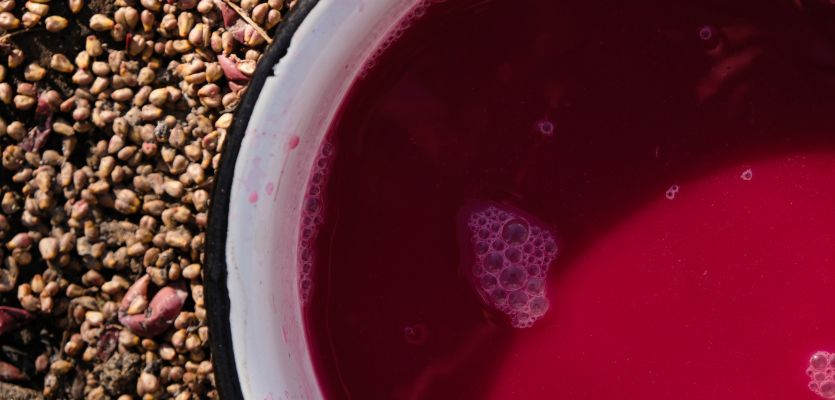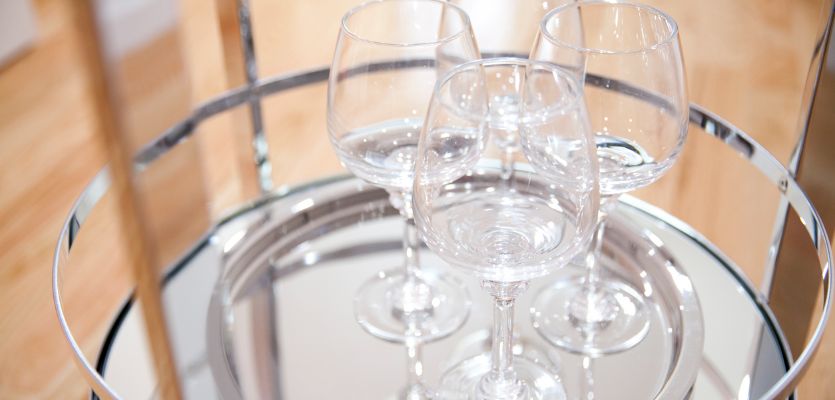What is Red Wine Vinegar?
Over the past two decades, red wine vinegar has become very popular both as a medical supplement and for cooking purposes. What is red wine vinegar? Red wine vinegar is a type of red wine that has been fermented and aged for 1-2 years for cooking purposes, but even though it contains alcohol, it is far too acidic and sour to drink like regular wine. For the most part, red wine vinegar is used in cooking to complement many types of foods, including salad dressing, pickles, marinades, sauces, and so on. Only a small amount of red wine vinegar is used as it has a potent taste. Aside from cooking, many people also believe that red wine vinegar has health benefits and regularly consume a small amount every day.

One of the key reasons why red wine vinegar has become popular in the kitchen is because it is low-calorie and fat-free. It is these features that make it popular among people who are concerned about weight gain.
What is red wine vinegar? In addition, red wine vinegar also contains trace amounts of minerals, like magnesium, calcium, iron, potassium, phosphorus, and Vitamin C. During the fermentation process, two other products are also generated, including probiotics and acetic acid, which can lower blood sugars and aid in digestion.
USE OF RED WINE VINEGAR
Depending on the amount, red wine vinegar can add a subtle sweetness and moderate acidity to the food. Some of the culinary uses of this include the following:
- Excellent substitute for traditional salad dressings. Some people prefer to use red wine vinegar over their salad instead of the traditional, heavy oil-based dressings because it is lower in calories.
- Can be used as a garnish or a flavoring agent for soups, pickles, and marinades.
- Enhance the taste of earthy foods, like caramelized onions, sauteed mushrooms, or asparagus.
Red wine vinegar is also a potent meat tenderizer. If you have tough meat, then add half a cup of red wine vinegar to the meat and cover it for 2-4 hours. Following this, wash the meat thoroughly to get rid of the vinegar flavor and aroma. The vinegar will break down the strong proteins and make the meat soft.
HOW TO MAKE RED WINE VINEGAR
If you need to learn how to make red wine vinegar, follow the following instructions. Take one-half cup of red wine and pour it into a canning jar that will be able to hold 64 ounces. Close and secure the lid and shake it to aerate the liquid. Then add water until the canning jar is ¾ full. Add the “live mother of vinegar” that you can either buy or make yourself to that mixture. Cover the jar with cheesecloth and fasten on with a rubber band. Set that sealed and covered jar somewhere dark for 3-4 weeks so it can ferment undisturbed. Check it now and then to make sure it isn’t growing mold. After a few weeks, the “live mother of vinegar” should descend to the bottom of the container, and you should begin to notice an aroma of vinegar in the concoction. It will take a couple of months to get to the full flavor that you want from red wine vinegar. Then it’s time to strain it with a colander or through a sieve lined with cheesecloth.
HOW TO SUBSTITUTE RED WINE VINEGAR
If you run out of red wine vinegar, fear not, you can use white wine vinegar, sherry vinegar, or champagne vinegar instead. However, the most common substitute is apple cider vinegar, which has a fruitier and tarty flavor but works very similarly to red wine vinegar. Balsamic vinegar, lime, and lemon juice also make a great substitute but only use a small amount as the flavor of these agents can be overpowering.
- Potential Health Benefits of Red Wine Vinegar
- Lowers blood sugar
- May lower the risk of certain cancers
- May protect your skin
- May aid weight loss
- May boost heart health
How to Store Red Wine Vinegar
Once you open a bottle of red wine vinegar, store the remainder in the refrigerator as this will add months to its shelf life. The unopened container should be kept in a cold dark place and out of sunlight.
What is red wine vinegar? Do you want to learn how to make red wine vinegar? If you have any questions about the red wine vinegar and its use, contact the experts at Pacific Rim & Company at 1-503-863-5454 or email us at: PacRimInfo@Banfi.com. We will be happy to assist you in answering your questions.
Wine Terms to Know: Wine Terminology
Many of us have walked into a wine conversation only to realize how little we understand about wine terminology and are at a loss for contributing to the discussion. Whether you are starting out as a wine drinker or simply want to increase your knowledge of wine terminology, here are some essential wine terms to know. Knowledge of these terms will let you communicate with ease with other wine drinkers or allow you to order wine at a restaurant with confidence. Below are some wine terms to know.

- Acidity. Acidity refers to the sourness in the wine. Wines with high acidity are sharp and make your mouth watery. Wines that have low acidity may taste flat but those with the right balance of acidity between tannins and fruits may feel lively or crispy. The wine’s acidity will depend on the grape ripeness and duration of fermentation. Unripe grapes tend to be very acidic, whereas overripe grapes tend to be sweet and fruity but lack acidity.
- Body. The body of a wine refers to the weight of the wine in your mouth. For example, water feels light and leaves no aftertaste, whereas a milkshake will feel heavy and leave a pleasant aftertaste. Similarly, some wines will feel heavy, while others will feel light. Full-bodied wines tend to have higher alcohol and/or sugar content. Light-bodied wines, on the other hand, feel watery. Classic full-bodied wines include Sauvignon Blanc, Cabernet, and Shiraz, whereas light-bodied wines include Pinot Noir and Rose.
- Complexity. A wine is said to be complex when it is rich in flavors, intensity, and aromas. In general, complex wines tend to have the perfect balance of tannins, acidity, and sweetness. Complex wines also tend to be harder to assess.
- Corked. When a wine has been contaminated with the cork, it is known as being “corked.” Sometimes fungi and some bacteria can grow inside the cork and produce a chemical called TCA. When this chemical comes in contact with the wine, it can contaminate the entire bottle, therefore ruining the wine. You will be able to tell when a wine is corked because it will have a musty, moldy, or off-putting flavor and a dry aftertaste.
- Earthy tones. An earthy wine will have flavors or an aroma of the natural environment, like the soil, fall leaves, hay, or mushrooms. Some wine drinkers like mild earthy wines; however, too many earthy flavors are not good because they can make the wine taste corked. Overall, earthy flavors tend to be more common in red wines, like Cabernet, Sauvignon Blanc, Pinot Noir, Merlot, etc.
- Wine Finish. The wine finish is the lasting impression one gets after swallowing wine. The finish often describes the texture and flavors that are left in the mouth after swallowing. If the duration of the finish is long, it indicates a good quality wine.
- Jammy. The term “jammy” refers to when a wine has a taste of fruit that has been cooked (especially berries) or will have a taste like jam. Jammy wines tend to be low in acidity and tannins and can be sweet. In the past, most wine drinkers did not prefer jammy wines, but lately, the new generation of wine drinkers love these wines.
- Nose. Besides drinking wine, it is important to smell the wine before tasting it. The nose will detect the aroma or the bouquet of a wine. Different wines have different aromas. The aromas also depend on other factors, like aging, fermentation, and exposure to oak.
- Tannins. Tannins in a wine are the cause of the drying sensation in the mouth. Wines high in tannins often taste bitter or astringent, whereas those with small amounts of tannins usually feel smooth or soft. Tannins are naturally occurring substances found in the seeds, skin, and stems of grapes. In general, white wines are made without the seeds or skin, and do not contain tannins. Sometimes, if the wine is aged in an oak barrel, it may absorb the tannins from the wood. Red wines are usually made with grape seeds and the skin and contain a varying number of tannins. The tannins not only cause a bitter taste, but can provide structure to the wine, which adds complexity to it.
- Vintage. Vintage essentially means the year the grapes were harvested. In most cases, the label will reveal the vintage, but if there is no vintage stated, it means that the wine was manufactured from more than one type of grape. The vintage also tells you something about the quality of the wine. Some years, the growing conditions are better than in other years.
This is a smattering of wine terminology for beginners. You will learn more wine terms to know as you increase your experience with the wonderful world of wines. To learn more interesting wine terminology and fun wine facts, visit Pacific Rim & Company, and if you have any questions call us at 1-503-863-5454, where our passionate employees are happy to help.
Wine and Sushi? An Unexpectedly Delicious Combo
Have you ever had wine with sushi? If there is one food that reflects good health and wellness, it has to be sushi. Not only is sushi very appealing to look at, but it comes with many types of ingredients, sauces, and dips. Sushi and wine pair nicely together, although you may not immediately think of it.

Essentially, sushi will feature medium-grain rice cooked in vinegar and served with either cooked or raw seafood. This is usually complemented with a range of fillings or toppings. One of the best things about sushi is that you do not even have to like raw fish or seafood. You can eat sushi with avocado or any type of favorite veggie. For the most part, sushi uses fresh ingredients and can be either vegetarian or non-vegetarian. There are six key types of sushi:
- Sashimi
- Nigiri
- Chirashi
- Maki
- Uramaki
- Temaki
Each has many subcategories, making sushi one of the most popular food choices for people of all ages. To make sushi taste even better, try pairing wine with sushi. Experimentation often brings new and rich flavorings to enjoy. Sushi and wine can definitely work well together. Since there are many types of sushi, there is no one type of wine that will necessarily complement all. The pairing of wine and sushi will depend on the flavor and type of ingredients in the food.
TIPS FOR PAIRING WINE WITH SUSHI
In general, you want a white wine with moderate acidity as it will pair with a broad range of fish used in sushi. These wines include Riesling, Chardonnay, Sauvignon Blanc, Gruner Veltliner, and Chenin Blanc.
Extremely acidic wines may not always pair well with all sushi because the high tannins and fruit may totally obliterate the flavor and aroma of the seafood. As well, the very high alcohol level can exaggerate the heat of the wasabi, making it uncomfortable to eat more.
If the fish is light, you need a crisp wine, like a Riesling or Gewürztraminer.
If you want to pair the heat of wasabi, then Riesling with residual sugar is what you want; the sugar can calm down the heat and intensify the flavors of the sushi.
If you prefer to consume red wines with your sushi, then go with the lighter or blended reds with mild tannins. If the wine contains too much tannin, it will make the fish taste metallic. In such cases, go with wines from the cooler climates in the U.S., like those grown in the soils of Washington state.
If the sushi is light, then the wine should also be light-bodied.
If the sushi has fatty fish, like salmon, you need wine high in acidity that will cut through the fat and access the protein. Great wines that pair well with fatty fish include Riesling, Chardonnay, Gruner Veltliner, and Pinot Noir, just to name a few.
If the seafood is mild or sweet but the fish is deep-fried, then go with a flavorful white wine with moderate acidity to match the sauce, such as Riesling.
If you love avocado sushi, then select a light rose as it will enhance the flavors of the wasabi.
If you do not like too much wasabi and want to minimize the heat, select a wine with residual sugar as it will quell the burning of wasabi (think Pinot Noir or Grüner Veltliner)
And, yes, you can select either red or white wine pairings with sushi.
CONCLUSION
While the general rule is that white wine should be paired with fish, this is not absolute. A glass of red wine can also make a great pairing. The key is to select a light-bodied red with mild tannins, like Pinot Noir, for a pairing of wine with sushi.
Try experimenting with a few wines at a time to sample sushi and wine. If you can choose only one, the best advice is to go with Riesling. This is a very versatile wine that pairs well with many types of food, including fresh seafood. With its delicate fruity flavor and acidity, it will melt most sushi in your mouth.
For more information about wine with sushi pairings and to learn about the exquisite wines Pacific Rim and Company offers, visit online or call 1-503-863-5454.
Things Your Wine Bar Cart Needs
Even though millions of people regularly drink wine, many do not have a dedicated wine bar cart. Why is a wine bar cart important? Well, for one, more often than not even simple items such as a corkscrew/bottle opener seem to disappear or get misplaced. This can make for a little frustration when it happens time and again and can take some of the fun out of drinking wine. Having a wine cart not only makes the needed accessories convenient, but more importantly, can also add aesthetics to your home. Plus, having all the bar cart essentials handy and in one place so you can get down to business sooner is ideal. If you drink wine regularly, it is highly recommended that you have a dedicated wine bar cart that can be stocked with supplies. What sort of items will you need for your cart? Let’s see.

THE WINE CART
The first thing you need to think about is size and shape. You need a wine bar cart that will easily fit into a space in your kitchen, on your deck, in your basement, or wherever you keep/drink your wine. There are dozens of wine carts on the market that meet all types of budgets, space needs, and personal preferences. Make sure the cart is sturdy and has wheels, especially if you are going to be moving it around often. Once you have the wine bar cart, then you can begin stocking it with the bar cart essentials. At this point, take some time to determine what type of wine drinker you are and how frequently you drink wine. Doing so will allow you to collect the right items for the wine cart.
Some essential items every wine cart should have include the following:
- Wine glasses. Choose glasses that are exotic, fun, or classic. There are hundreds of styles and designs of wine glasses available, but select glasses that are functional, easy to clean, and durable as well.
- The beverages. Once you have the glasses sorted out, stock up with your favorite alcoholic beverages, which may include vodka, gin, rum, whiskey, or tequila, just to name a few.
- Non-alcoholic drinks. Additional beverages, such as sparkling water and lemon juice, should be two basic items you always have on hand.
- Ice bucket and tongs. Next, an ice bucket is essential, but buy something that is visually appealing as well as functional.
- Pitchers and punch bowls. To serve your cocktails and wines, you should also have punch bowls and pitchers on hand.
- Coasters and napkins. To avoid making a mess from spilled drinks, remember coasters and napkins.
- Corkscrews and bottle opener. For opening wine, you should have at least two wine bottle openers.
- Bottle stoppers. These are essential if you want to preserve your opened wine bottle for another day.
- Aerator. Wine lovers should own a bottle aerator. In most cases, wine can be enjoyed right out of the bottle and will improve shortly after being poured into the glass; however, a true connoisseur knows that to truly unlock the flavor in any wine, letting some oxygen enter the beverage will soften and smooth the tannins. This is especially true for any astringent and bitter overtones that might be found in young wines. By pouring your wine into a decanter or using an instant aerator, you allow for instant aging to occur that mellows the wine, while also bringing out more of its complexity and aroma.
- Decanter. Just like an aerator, a good decanter can help aerate your wine, providing you with a beverage that is smooth and has well-balanced flavors.
- Polishing cloth. If you want your wine glasses to be spotless, invest in a polishing cloth.
- Serving tray. All good hosts and hostesses should have a serving tray available. If you are going to be serving charcuterie or any type of snack with your wine, you will need a visually appealing serving tray.
Whether you are a casual wine drinker or a wine connoisseur, you can make the activity more enjoyable by having a wine bar cart. There are a variety of gizmos and gadgets on the market to choose from but be practical and choose items that you will use regularly. Choose the bar cart essentials that specifically apply to your needs.
Visit Pacific Rim & Company or call us at 1-503-863-5454 to learn more. To stock your cart with delicious and affordable wines, here are some great selections for your consideration:
- 2021 PACIFIC RIM WICKED GOOD RED
- 2020 SWEET RIESLING
- 2018 RAMOS VINEYARD GEWURZTRAMINER
- 2018 SPRING CREEK VINEYARD GRÜNER VELTLINER
How to Store Opened Red Wine
An open bottle of Pacific Rim wine is a delicious invitation, but what happens if you’re left with little choice but to store part of the bottle for later? It absolutely happens, and learning how to store opened red wine for a few days until you can revisit it is an absolute must.

Why Storing Open Red Wine is Even Necessary
Not sure why there’s such a fuss about storing the wine in the first place? It’s actually oxygen’s fault. Oxygen has the power to turn red wine basically into vinegar. Keeping the amount of oxygen that touches the surface of the red wine to a minimum is what can help prolong its shelf life, giving it as long as five extra days before you have to dump the rest of the bottle.
How to Store Opened Red Wine - A Step-by-Step Guide
If you do decide you can’t finish the bottle, there are a number of things you should do immediately. It starts the moment you uncork. After you pour a glass, re-cork the wine immediately. The “clean” side may seem like it fits easily in the bottle, but that’s the last thing you want to do. You want to use the stained side, as it’s already been exposed to the wine itself.
When you put it away, go ahead and store it in a darker place that is cooler than room temperature, even if you think you might go back for a second glass. A refrigerator is a good choice, as it helps to slow the chemical process of oxidation down.
As you put it in the refrigerator, be sure to store it upright. Storing it on its side means increasing the surface area that is exposed to the oxygen that will eventually ruin your wine.
Other Options
There are other options in the world of wine preservation. In fact, if you’re looking to learn how to store opened red wine, you’ll quickly come across vacuum pumps and more. Many restaurants even use some of these options. They all work in a similar fashion. They eliminate the oxygen in a bottle in one way or another. Vacuum pumps just suck it out so the bottle can be resealed, and most are fairly affordable. They can keep your wine fresh for at least two weeks. Wine gas preservation systems work a bit differently. They insert an inert gas, like argon, into the bottle to displace the oxygen. That creates a protective layer around the wine, helping it stay good for quite some time. While these are great options, some can get expensive.
Storing red wine may seem frustrating, but once the bottle is open, it’s a necessary skill. Enjoy your glass of red wine now, and if you must store it, do so carefully.